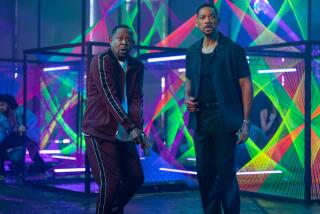Netflix’s ‘Rodney King’ has Spike Lee and his muse looking back
Roger Guenveur Smith recalls that he had a deeply emotion reaction when he heard Rodney King had died in 2012. And he couldn’t understand why.
“Here is someone I didn’t even know, had never met,” the actor and monologuist said. “I kept asking ‘why did his death affect me so much?’”
The answer wasn’t simple. But the question kickstarted a complex process — one that would culminate in “Rodney King,” a one-man show about the many facets of the victim of police brutality.
Smith was speaking by phone from Portland, Ore. After nearly five years of serious road time, he was just a few minutes away from taking the stage for the last-ever performance of his searing piece. (He gave it one final go-round at Los Angeles’ Bootleg Theater, where he’d workshopped it years ago, in March.)
Thanks to Netflix, though, “Rodney King” will live on — and be available to a much wider audience than the people that since 2012 have packed small theaters around the country to see it. Spike Lee shot a performance in New York one recent summer, applying some Spike-ian directorial touches, and Netflix began streaming it Friday to coincide with the 25th anniversary of the L.A. Riots.
As television prepares to mark those dark days with sweeping historical pieces, “Rodney King” goes the other way: It asks, in ways journalistic and imagined, who the man at the center of it all really was. King does serve here as a kind of blank slate for our notions of victimhood, resistance and harmony. But he also transcends all of those things.
We don’t want to make Rodney King a symbol of the oppressed black man. We want to portray him as a human being...”
“We don’t want to make Rodney King a symbol of the oppressed black man,” Smith said. “We want to portray him as a human being — a man who loved to fish, a man who was listening to De La Soul when he was pulled over, a man who was a second-generation alcoholic drowning victim.”
Smith’s piece is a grounded depiction, rich in unexpected detail: the Bob Marley wig he donned to observe the riots incognito; the father who alternately bonded with and beat him; the fact that he actually knew Reginald Denny, the white truck driver nearly killed in the riots, from a moment they shared at a construction site.
It is also, it should be said, a provocation.
Smith delivers the material sweatily, breathily, pulsatingly, with a musicality to his voice and a meter to his patter. (“You wanna reminisce/it goes something like this/91, 92/Come on, Rodney King you know what to do/It was a Saturday night/Right?/And you were chilling at your boy’s crib watching the fight.”)
The tone can go from confrontational to plaintive and back again. Smith starts with an invocation of the Geto Boys’ accusation of the subject as an Uncle Tom (“… Rodney King”)— unattributed to throw us off balance — and ends by recounting, in its entirety, the beautiful tentativeness of King’s landmark speech (“People, I just, I just want to say, you know, can we, can we all get along?”).
In between, in segments he’s improvised and honed over the years — years in which King’s legacy loomed over high-profile incidents of police brutality and the Black Lives Matter movement — Smith explores the man himself. Using a kind of egg-on second person tone (“Right, Rodney?”) The performer is often filling in the details of King’s life, challenging and provoking him, but really, challenging and provoking the many assumptions we’ve made about him, his reduction into a symbol. “Rodney King” conveys the poignant tragedy of its subject’s story, but also the ways our understanding of that story has betrayed him.
“Rodney King was not somebody who tried to be somebody he was not,” Smith said. “They tried to give him courses in black history; they wanted him to be a spokesperson. But he was a spokesperson for nothing but his own agenda.”
Underscoring Smith’s point: King was known to his friends as Glen, his middle name; his first name, Rodney, was simply what the police report had down — so that the King the world knew was quite literally not the man he actually was.
Lee and Smith have teamed up on some nine projects, including “Do the Right thing” and “Malcolm X.” In the mid-1990s they also worked on Smith’s one-man show “Huey P. Newton.” another story about a black man inaccurately iconized.
“What Roger is doing, like Mark Twain and many of our best storytellers, is humanizing someone who’s been made into a demon, an animal, into less of a human being,” Lee explained. The director shot the piece with more than a dozen cameras, often going close-in on the performer, sometimes trailing down his body to match a point Smith was making. At the end the lens pulls back on Smith, giving a sense of both loneliness and cosmic-ness. The piece was also shot against the backdrop of New York’s East River, a melancholic counterpoint to King’s death in a swimming pool.)
Because of its tone, “Rodney King” can have an odd effect. One can feel provoked and placated, unsettled and in harmony — often at the same time.
This, Smith said, is by design. “The audience is alternatively seduced and indicted. Is it an angry piece or a conciliatory piece? Those are cliches.”
Right before March’s Bootleg performance, Smith heard from Juan King, asking if he could get a ticket to see the show. Rodney King’s brother had a dramatic back story in his own right, and the request reminded Smith of all the tales that have gone untold. All he could do was hope to be specific about one man and, in that way, universal about everyone else.
“Rodney King was without artifice, without pretense,” Smith said. “In him I have — the audience has — recognized someone we know.”
See the most-read stories in Entertainment this hour »
Twitter: @ZeitchikLAT
ALSO
Review: Roger Guenveur Smith’s ‘Rodney King’ at the Kirk Douglas Theatre in 2013
‘History happened here’: Oscar winner John Ridley revisits the 1992 riots in his new documentary
Trio of L.A. riot documentaries look back to 1992
Angelenos talking to Angelenos: Covering the L.A. riots when local news still mattered
John Singleton looks back on the 1992 L.A. riots in new documentary
More to Read
Only good movies
Get the Indie Focus newsletter, Mark Olsen's weekly guide to the world of cinema.
You may occasionally receive promotional content from the Los Angeles Times.











